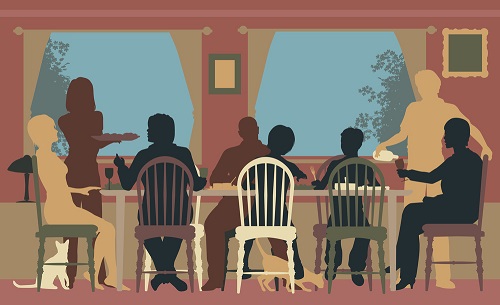What is civic education, and why does it matter? Further, what constitutes civic education, and whose task should it be to ensure a nation's citizens are civically literate? These are the questions this edition of Liberty Matters hopes to explore, beginning with our lead essayist, David Davenport. Davenport will be joined by Mark Schug, Rachel Davison Humphries, and Lee Trepanier to discuss the fate of liberty and republicanism.
Response Essay Reflections on the State of Civics Education in America

My overall response to the essay by David Davenport is very positive. It is a concise and insightful analysis of the state of civics education in America today. While much of it is a little depressing, his essay defines the problem and presents some actions to address it. My response mainly attempts to elaborate on some of the important points he makes.
Defining the Problem
Davenport is on target when he chooses to begin his essay by referencing the Founders’ views regarding the importance of civics education. The failure to explicitly mention education in the Constitution meant that the Founders regarded education as properly a state and local matter. Nonetheless, John Adams, Thomas Jefferson, James Madison, and George Washington all agreed that maintaining a well-functioning republic required a strong and robust civics education.
The Founders were influenced by the Enlightenment scholars, a group that included John Locke and Montesquieu. Moreover, the economist Adam Smith published his best-selling book Wealth of Nations in 1776, the same year as the Declaration of Independence. In his previous book, Smith had explained that patriotism is part of human nature. He wrote in Theory of Moral Sentiments (1759):
“The love of our country seems, in ordinary cases, to involve in it two different principles; first, a certain respect and reverence for that constitution or forms of government which is actually established; and secondly an earnest desire to render the condition of our fellow citizens as safe, respectable, and happy as we can.” (Page 231)
The Founders were aware of Smith’s work. George Washington had a copy of Wealth of Nations in his library. Thomas Jefferson acquired a copy of Wealth of Nations while he was in France. James Madison nominated Wealth of Nations to be one of the books in the proposed congressional library.
The Status of Civics and History Education
I have been following the National Assessment of Education (NAEP) in civics and history for decades. It is all very depressing. As Davenport notes, the outcomes for civics learning are depressing and for history it is “shocking.”
The NAEP results are even more discouraging when placed in a somewhat larger curricular context. In the late 1970s and early 1980s, there was a series of National Science Foundation reports that addressed the status of science, mathematics, and social science education in the K-12 curriculum. (Morrissett, L., Hawke, S. and Superka, D. (1980) The Status of Social Studies Education: Impression from three NSF Studies. Social Education 43 150-153) The social studies elementary curriculum was described as a “widening horizons” design. It started with self and school (K), family (grade 1), neighborhoods (grade 2), communities (grade 3), state history and geography (grade 4), and two semesters of American history (grade 5).
While the widening horizons approach has many shortcomings, the early grades contained patriotic content including the celebration of national holidays, guest speakers such as police officers and firefighters, and field trips to historic museums and parks. Students often learned about key moments in American history, famous Americans, and positive stories of historical figures like George Washingtom, Abraham Lincoln, and Harriet Tubman. The elementary grades culminated with two semesters of American history at grade 5. Much of this has simply vanished.
For the upper grades, American history was most often taught at grade 8 (2 semesters) and again at grade 11 (two semesters). American government was often taught at grade 9 (one or two semesters) and at grade 12 (2 semesters). Civics, as pointed out by Davenport, has generally eroded into one-semester course.
Downstream Effects of Poor Civics Education
Davenport does an excellent job explaining the erosion of Americans’ trust in government, low voter turnout, and reduced civic participation. The head scratcher for me has been how young people concluded that socialism is a good thing and capitalism is a bad thing. Most economists do not need to be convinced that market economies create wealth. Many economists are well aware that the individuals who stand to gain the most from free markets are those without inherited wealth, prestigious credentials, or class advantages.
Davenport illuminates how young people hold contradictory views of socialism and markets. They favor socialism. but they often define it differently than the way it is taught in economics. However, they favor markets over government when directly asked. This suggests that American history (and perhaps economics) courses have utterly failed to stress the evils of communism and socialism. Students should grasp the realities of life in the former Soviet Union, Mao's China, and contemporary North Korea, Cuba, and Venezuela.
Finally, I'd like to introduce one more point concerning what many perceive as the "socialist" nation of Denmark. The Freedom of the World Index published by the Vancouver-based Fraser Institute ranks the nations of the world according to size of government, legal system and property rights, sound money, freedom to trade internationally, and regulation. In the 2022 report, Denmark ranks fifth globally in economic freedom, above Australia (ranked sixth), the United States (ranked seventh), Canada (ranked 14th), and United Kingdom (ranked 22cd). While Denmark does indeed rank low in terms of size of government (ranked 138th in the world), it excels in areas such as legal system and property rights (ranked 10th in the world), sound money (ranked 10th in the world), freedom to trade (ranked 6th in the world), and regulation (ranked 6th in the world).
Flawed Curriculum
Davenport effectively critiques the "revisionist and politicized" content of curriculum materials such as The 1619 Project and Howard Zinn's book, A People's History of the United States. Allow me to provide further observations regarding these two issues.
In August of 2019, The New York Times magazine published a special issue announcing, “The 1619 Project.” In the online announcement, the Times’ editor in chief proclaimed the purpose of the project as follows:
The 1619 Project is a major initiative from The New York Times observing the 400th anniversary of the beginning of American slavery. It aims to reframe the country’s history, understanding 1619 as our true founding, and placing the consequences of slavery and the contributions of black Americans at the very center of our national narrative.” (Silverstein, 2019)
As pointed out by Peter Wood in his book responding to this project (2020), this is an unusually ambitious goal for a magazine, typically left to historians and scholars of the field. In fact, well-known historians of diverse political views have written letters and articles pointing out numerous factual errors in this project. In response to reviews from these historians and many others, the Times quietly removed the reference to the “true founding” in its online announcement. Under the pressure of open criticism, the Times’ editors issued corrections to other essays in the project, even while accepting a Pulitzer Prize for their work.
The lead essay in the project is titled “Our Founding Ideals of Liberty and Equality Were False When They Were Written. Black Americans Fought to Make Them True. Without This Struggle, America Would Have No Democracy At All.” This essay by Nikole Hannah-Jones asserts that the Revolutionary War was fought primarily to protect slavery. Under criticism from historians on both the right and the left, the Times issued what it called a small clarification, saying that “some of” the colonists fought the American Revolution to defend slavery. Even after this correction, historians nearly unanimously reject the contention that slavery was a primary motivator for the Revolution. A cursory examination of writings from the leaders of this time makes such an assertion difficult to sustain:
“There is not a man living who wishes more sincerely than I do, to see a plan adopted for the abolition of [slavery]. – George Washington, Letter to Morris, 1786
“… [E]very measure of prudence, therefore, ought to be assumed for the eventual total extirpation of slavery from the United States …. I have, through my whole life, held the practice of slavery in abhorrence … .” – John Adams, Letter to Evans, 1819
“Slavery is … an atrocious debasement of human nature.” – Benjamin Franklin, an Address to the Public from the Pennsylvania Society for Promoting the Abolition of Slavery, 1789
Davenport is correct in highlighting Howard Zinn’s A People’s History of the United States as a major contributor to the absence of robust civics education. The work has been criticized for its inaccuracies and selectivity of facts. The review by Sam Wineburg helped to discredit Zinn. Yet the book has sold over 2.6 million copies. The 1619 Project is small potatoes in comparison. A People’s History is used as a textbook in many high schools and appears on the reading lists of numerous college courses.
Since 2008, Zinn’s openly Marxist approach has grown with the addition of the Zinn Education Project (ZEP) (https://www.zinnedproject.org). ZEP has partnered with Rethinking Schools, a leftist social justice organization that began in Milwaukee in 1986, and with Teaching for Change.
ZEP provides lesson plans, newsletters, conferences, and other activities to support the “people’s history” approach inspired by Zinn. The website reports that over 123,000 teachers are signed up for its materials, and claims that it has reached millions of students. To place this in context, the National Council for Social Studies, the largest organization of social studies teachers, claims to have a membership of about 10,000 teachers.
Here is a quote from Corey Winchester, a teacher at high school history in Evanston, Illinois:
“I’ve used the Zinn Education Project’s materials since my first-year teaching. Nine years later, my students can speak to the power of deconstructing the narratives of Christopher Columbus and Abraham Lincoln’s efforts that have replicated white supremacy and marginalization of people of color in historical discourse.For many of them, it is empowering to learn from multiple perspectives and invigorates desire to learn and disrupt the status quo.”
Only a handful of article-length critiques of A People's History have been written, which is surprising given the book's popularity. By contrast, Mary Grabar’s book Debunking Howard Zinn: Exposing Fake History that Turned a Generation Against America (2019) stretches to over 300 pages. She begins by commenting on Zinn's rock star status; indeed, A People's History received mentions in the movie "Good Will Hunting," was featured in "The Sopranos" and "The Simpsons," and Zinn's death in 2010 catapulted it near the top of The New York Times paperback nonfiction list. He was even honored with tributes on "Saturday Night Live" and MTV. More recently, Zinn is reported to have inspired plays, movies, Black Lives Matter, a BBC series, and Occupy Wall Street.
Grabar suggests that Chapter 1 of A People’s History was the inspiration that kicked off the movement to abolish Columbus Day. She writes that “in October of 2018, San Francisco, Cincinnati, and Rochester, New York joined at least sixty other cities in replacing Columbus Day with “Indigenous Peoples’ Day.” Many articles reporting on the movement to get rid of Columbus Day came back to Zinn.
Grabar meticulously dissects Zinn’s writing, offering strong rebuttals at every turn. In Zinn’s world, America is the most racist country in the world. The American Revolution was merely a way for the elites to remain in power. Capitalism is America’s greatest evil. Hitler’s Germany was no worse than the United States. The Soviet Union was never a threat to the West. The Cold War was just a power grab.
Zinn never claimed to be an objective historian. He wrote from a Marxist narrative model of history which means that he decided in advance on the overall story and then forced the evidence he cited to fit into that story. How on earth would young readers know they were being deceived? After all, the book was probably given to them by their teachers. Thus, young people are led through a series of errors of omission, errors of commission, and out-right falsehoods to conclude that America is inherently evil.
Good News
I concur with Davenport's suggestions for improving civics and history education, which include fostering "informed patriotism," expanding civics in the K-12 curriculum, increasing NAEP testing, and utilizing primary sources.
Allow me to recommend some specific reading and curriculum materials that teachers and readers may find valuable to improve civics education.
Wilfred McClay’s book Land of Hope: An Invitation to the Great American Story (2019) has a traditional table of contents with 22 chapters. The book is primarily a political history, and it gets the economics right. While many textbooks are encyclopedic, McClay is concise, clocking in at 459 pages. America’s story, warts and all, is told without interruption. The primary audience is students in grades 9 to 12. McClay’s objective is to provide an “accurate, responsible, coherent, persuasive, and inspiring account of their own country—an account that will inform and deepen their sense of the land they inhabit and equip them for the privileges and responsibilities of citizenship.” (page xi)
The Ashbrook Center, an independent academic center located at Ashland University, was established and named in honor of the late Congressman John M. Ashbrook, who represented Ohio’s 17th Congressional district for 21 years. President Ronald Reagan personally dedicated the Ashbrook Center on May 9, 1983. While based in north central Ohio, Ashbrook offers educational programs across the country for students, teachers, and citizens.
The Hillsdale 1776 Curriculum is a complete collection of lesson plans for teaching American history, civics, and government to K-12 students. Students who study using this curriculum learn about American history from the colonies through the Civil War at four different times during their K-12 years, each time increasing in depth. The curriculum also includes American history since the Civil War and American government and civics for both middle and high school students. This curriculum provides teachers with guidance—not dictates—about how to plan and teach a given topic in American history or civics. This guidance includes Hillsdale College-vetted books, online courses, and other resource recommendations; lists of content topics, stories to tell, and questions to ask of students; “Keys to the Lesson” that clarify important points for teachers to keep in mind; student-ready primary sources; and sample assignments, activities, and assessments.





